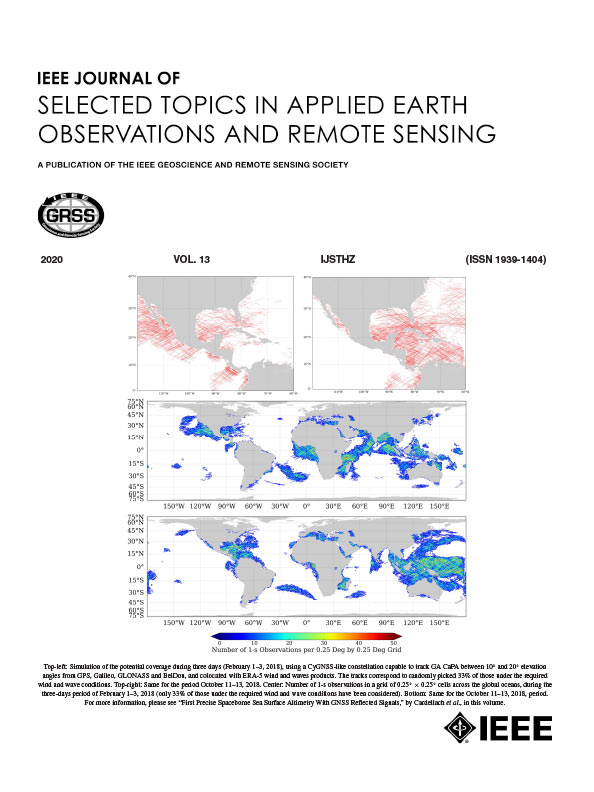Monitoring Snowmelt in Mountainous Areas by Considering SAR Geometric Distortion From Ascending and Descending Orbits
IF 5.3
2区 地球科学
Q1 ENGINEERING, ELECTRICAL & ELECTRONIC
IEEE Journal of Selected Topics in Applied Earth Observations and Remote Sensing
Pub Date : 2025-06-19
DOI:10.1109/JSTARS.2025.3580604
引用次数: 0
Abstract
Synthetic aperture radar (SAR) multitemporal and multipolarization change detection method has been widely utilized for wet snow extraction. Although SAR terrain correction can alleviate the geometric distortion caused by foreshortening and layover, it fails to fully eliminate terrain shadows and great layover effects on steep slopes, presenting significant challenges for high-precision monitoring of snowmelt. This study proposes a method for identifying snowmelt in mountainous areas by combining Sentinel-1 ascending and descending orbits data, taking advantage of the significant differences in geometric distortion areas between two types of orbits that transit on the same day. First, geometric distortion areas and reliable areas are identified on the Sentinel-1 ascending orbit images (evening) and descending orbit images (morning) using radar and local incidence angles, respectively. Wet snow is extracted from each reliable area using SAR multitemporal and multipolarization change detection algorithm. Then, the Sentinel-1 images of the two orbits are combined to obtain the reliable areas with minimal geometric distortion, and wet snow information is obtained through wet snow priority method and reliable areas priority method. Using the Babao River Basin in the Qilian Mountains as the study area, the data were accessed through the Google Earth Engine (GEE) and analysis was run on GEE. At the same time, in order to accurately extract the snow cover range, the spatiotemporal data fusion model was employed to simulate Sentinel-2 images that transit on the same day as Sentinel-1. Finally, the extracted dry/wet snow was corrected using a digital elevation model to determine the distribution of dry/wet snow in the Babao River Basin for a hydrological year from September 2021 to August 2022. Using 71 field measurements of snow water content for accuracy verification, the results indicated that the overall accuracy of using combined ascending and descending orbits data increased from 71.2% for descending orbit alone and 72.4% for ascending orbit alone to 81.7%.考虑上升轨道和下降轨道SAR几何畸变的山区融雪监测
合成孔径雷达(SAR)多时相多极化变化检测方法在湿雪提取中得到了广泛的应用。SAR地形校正虽然可以缓解缩短和中途停留造成的几何畸变,但不能完全消除地形阴影和陡坡上较大的中途停留效应,给融雪的高精度监测带来重大挑战。本文提出了一种结合Sentinel-1上升和下降轨道数据识别山区融雪的方法,利用两种轨道在同日过境时几何畸变区域的显著差异。首先,利用雷达和局部入射角分别对Sentinel-1上升轨道图像(傍晚)和下降轨道图像(清晨)进行几何畸变区和可靠区识别。利用SAR多时相多极化变化检测算法从各可靠区域提取湿雪。然后,将两个轨道的Sentinel-1图像进行组合,得到几何畸变最小的可靠区域,并通过湿雪优先法和可靠区域优先法获得湿雪信息。以祁连山八宝河流域为研究区,利用谷歌地球引擎(GEE)获取数据,并在GEE上进行分析。同时,为了准确提取积雪覆盖范围,采用时空数据融合模型模拟与Sentinel-1同日过境的Sentinel-2影像。最后,利用数字高程模型对提取的干/湿雪进行校正,确定了2021年9月至2022年8月八宝河流域一个水文年的干/湿雪分布。利用71个雪水实测数据进行精度验证,结果表明,综合利用上升和下降轨道数据的总体精度由单纯下降轨道数据的71.2%和单纯上升轨道数据的72.4%提高到81.7%。
本文章由计算机程序翻译,如有差异,请以英文原文为准。
求助全文
约1分钟内获得全文
求助全文
来源期刊
CiteScore
9.30
自引率
10.90%
发文量
563
审稿时长
4.7 months
期刊介绍:
The IEEE Journal of Selected Topics in Applied Earth Observations and Remote Sensing addresses the growing field of applications in Earth observations and remote sensing, and also provides a venue for the rapidly expanding special issues that are being sponsored by the IEEE Geosciences and Remote Sensing Society. The journal draws upon the experience of the highly successful “IEEE Transactions on Geoscience and Remote Sensing” and provide a complementary medium for the wide range of topics in applied earth observations. The ‘Applications’ areas encompasses the societal benefit areas of the Global Earth Observations Systems of Systems (GEOSS) program. Through deliberations over two years, ministers from 50 countries agreed to identify nine areas where Earth observation could positively impact the quality of life and health of their respective countries. Some of these are areas not traditionally addressed in the IEEE context. These include biodiversity, health and climate. Yet it is the skill sets of IEEE members, in areas such as observations, communications, computers, signal processing, standards and ocean engineering, that form the technical underpinnings of GEOSS. Thus, the Journal attracts a broad range of interests that serves both present members in new ways and expands the IEEE visibility into new areas.

 求助内容:
求助内容: 应助结果提醒方式:
应助结果提醒方式:


